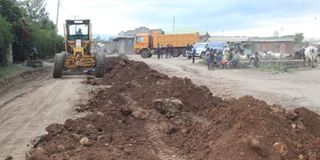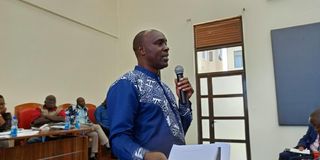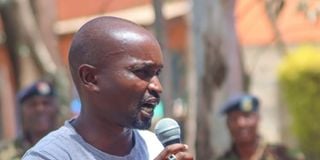Imarisha Barabara: How the Sh 70.5 million project works

Grading and murraming works of the 2.3 Kilometres Kongasis-Oljorai- Kampi Muindi Road in Gilgil Sub county.
Immediately Susan Kihika came into power, like many before her, she launched her ground breaking, revolutionary, and absolutely-done-before flagship project dubbed 'Imarisha Barabara'.
In its slight change of name from that of her predecessor who had named it Boresha, her administration has positioned this project as a key driver aimed at ‘opening up the entire county through an improved road network to spur socio-economic development among residents’.
The Sh. 70.5 million project, according to the 2023/24 medium term expenditure framework, focuses on both upgrading existing roads and opening new ones, with a particular emphasis on rural areas that have historically been underserved.
How does it work?
As a flagship project, the executive arm of the government has set aside some money to cater to this specific project, and so have the Members of County Assembly (MCAs) which according to several, is some Sh. 25 million every financial year that they get to divide equally amongst themselves.
This share of the money goes towards fuelling the vehicles as the heavy-duty work remains with the Department of Roads.
We spoke to several Members of the Nakuru County Assembly who hold different views about the project.
Naivasha East ward MCA, Stanley Karanja, notes the progress of the project, noting that while they have been able to open up new roads to completion, many are still pending.

Naivasha East MCA Stanley Karanja addressing the gathering at Ugatuzi Plaza during the public participation on 8th March, 2024.
“Success of completed projects often depends on the funds allocated,” he explains. “As leaders, we enhance our budgets to cater to fuel for equipment, like bulldozers, to what is already allocated to ensure the completion of these graded roads.”
However, he notes many roads remain unfinished or unopened due to time constraints.
“When the machines- a grader, lorry, and excavator- come to your ward, and it rains, this means the machines will not work, hindering the progress of the project as we are always given a week,” Karanja laments.
He adds that the greatest challenge has been the breakdown of machines, delays in accessing fuel as it passes a tedious procurement process, which takes too much time, and the nature of vast roads in the county.

Some of the equipment used in Imarisha Barabara project.
Malewa ward MCA, Francis Kuria, agrees with his counterpart that sometimes the project takes longer due to bad weather.
“For example, Kuresoi experiences a lot of rainfall, which can interfere with our planned activities. When it rains, we face delays in grading and murraming, leading to us skipping or avoiding some areas. Once the rain stops, we resume work, but we often have to reschedule the program due to the limited time,” he explains.
Due to this carrying forward, we question where the money goes, as there is a specific allocation to the MCAs every financial year.
Kuria notes that in instances where the project is not actualized, they carry forward the money and are forced to reschedule.
“We've been working to upgrade our allocations to not only cover fuel but also the installation of culverts and murram to compensate for lost time due to bad weather. So, when we cannot do grading and murraming, those (other MCAs) who prefer to do the installation of culverts and gabions can go on to ensure the work is done,” says the chairman of the roads committee.
However, he says they face a shortage and breakdown of equipment, with one grader, one roller, and two trucks expected to cover wards within the five regions. While this is so, he adds that they are lobbying to acquire more equipment to help speed up the process.
We also ask how viable the project is, seeing that they oversee its implementation compared to leaving it through a tendering process.
Kuria notes that this would need an inflated budget because Sh. 1.5 million would be required to finish a kilometre of road.
“Constructing 1 kilometre of road through the contracted method costs Sh. 1.5 million,” he explains. “However, under the 'Imarisha Barabara' program, the same amount can fund 5 kilometres of road. So, if properly managed and facilitated, the program has the potential to significantly improve our road infrastructure, making it one of the most efficient initiatives available.”
The MCA of Lanet Umoja, Samuel Ngarama, begs to differ and says he does not see the point of the project, which he later clarifies.

Lanet Umoja MCA Samuel Ngarama.
“I’ve never budgeted for the program from my ward kitty because I have never seen how helpful the project is,” he says.
We question if this is optional, to which he says it is.
“I fail to understand how the county has machinery for the project, and almost half of the time, they are often lying dormant because they lack fuel,” Ngarama laments. “It is better to hire a contractor who’ll come do the job and leave.”
He divulges how he’s been noticing how the project machinery is used to conduct personal business yet, wards are suffering.
“Sometimes you can see the same machines, purported to not have fuel, especially the ‘kanjo’ trucks running around transporting gravel or stones using taxpayers’ money, but when I need it to come to my ward, I am always told there’s no fuel,” he says, sounding unsurprised.
Ngarama says the project has never been implemented in his ward since he and the governor all came to office and has questioned it severally.
“In Lanet, we have never received those machines since I was elected. I keep asking the Chief Officer (CO) from the Department of Roads where Lanet’s allocation for the project has been going. ‘Tumekua tukisumbuana sana’.”
He adds that recently the machines were sent his way but were lying idle because they had no fuel, so they sat there.
Now, because he has not been receiving the roughly allocated kitty to his ward from the executive side of the government since the Governor’s first year in office, we ask where the money goes, and he says we need to ask the executive arm of the government as he does not know.
"They are the ones who can tell us and should be held accountable,” he says. “I have complained about this issue several times, and it caused a lot of problems. In the last two financial years that we’ve been in office, those machines have never come to us. When asked, they resolved to say that sometimes the allocation is used for ‘emergencies’,” Ngarama explains.
We ask if this money is being misappropriated, to which he elucidates more on the issue.
“You know you can’t verify that since the funds are supposed to come in the form of fuel. For example, in the Mai Mahiu instance, all those machines went there, and they had no money for that work, so the remainder of the budgeted fuel money was used there, according to the executive,” he says.
He further explains, eluding himself from the trouble, “When you’re told something like that, yours is to wait for the auditors who are expected to verify where that money went.”
And the existing budget, we ask?
“When money is budgeted for a specific purpose, it should be used for that purpose, which is why we have a budget. I don’t understand why someone would come and tell me that money allocated for a certain item was used elsewhere and wasn’t in the budget- that defeats the logic of having a budget,” Ngarama remarks sensibly.
To avoid the back and forth with the executive, Ngarama says he’s made an effort to budget for the program through the supplementary budget, which will cater to the purchase of fuel and murram to an understanding that he’s had to come to with the CO.
“The only way I saw for this project to work is to set aside my allocation to the supplementary budget so that I don’t get excuses and have an understanding with the CO for this to happen. If all of us are told to set aside funds like this for fuel and assured it won’t be diverted because it is from the kitty, then things may work,” Ngarama says optimistically.
